They’re cool. They’re cutting edge. And some of them are downright weird. They’re the cars of the future.
And if these concept cars are any indication of what’s to come, we’ll be seeing more and more crossover vehicles that aren’t so easy to categorize. Take, for example, the Chrysler Pacifica – part car, part SUV, part minivan – dubbed a “sports tourer” by Chrysler, further exacerbating the confusion. Other unveilings, however, are easier to classify, such as the Tonka truck from Ford, a much bigger version of your toy truck from childhood. There are also some familiar models reinvented, such as Chrysler’s Jeep Willys2 and Nissan’s Quest minivan, along with one that harkens back to the mid-1950s: Chevrolet’s Bel Air.
If you didn’t make it to the show in Detroit, this sampling of concept vehicles will give you an idea of what the car manufacturers have up their sleeves.
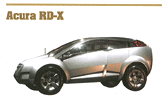
Acura RD-X
What do you get when you cross a sport couple with an SUV? The RD-X. This concept SUV designed and developed by Honda R&D Americas combines the street performance of the RSX sports coupe with the four-wheel drive capability of the MDX sport utility. Geared toward young, urban professionals who “work hard during the week and play harder on weekends,” the vehicle features an Integrated Motor Assist (IMA) system with twin electric motors to power the rear wheels when extra driving force or traction is needed. Stow-away rear seats also leave plenty of room for all that extreme sports gear.
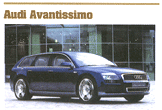
Audi Avantissimo
This luxury station wagon (yes, luxury station wagon) is based on the Audi A8, with a 4.2-liter bi-turbo engine under the hood borrowed from Le Mans race cars. (Yes, a luxury station wagon with a turbo engine. You go Mom!) Rather than a single large one, the bi-turbo uses two smaller turbochargers. The Avantissimo also features a flat cargo floor that slides out electronically for ease of loading and a second row of seats that lowers for additional cargo room.

Chevrolet Bel Air
This may look like the 1955-’57 convertible, but its engine is pure 2002. The Bel Air is powered by a Vortec 3500 turbocharged inline 5-cylinder concept engine based on the inline engine family that debuted in GM’s mid-size SUVs. The all-aluminum engine delivers up to 315 horsepower and 315 lb.-ft. of torque, and is mated to a Hydra-Matic 4L60-E electronically controlled 4-speed automatic transmission. A button on the steering wheel activates the powertrain control module to trigger a more aggressive spark and fueling calibration for maximum horsepower. In addition to the exterior styling, the design team also captured a bit of the original Bel Air by including a traffic light viewfinder and by putting the gas filler cap in the taillight.
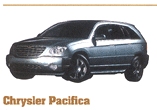
Chrysler Pacifica
Attention soccer moms, the pacifica goes into production next year. What is it exactly? The Pacifica is part car, part SUV and part minivan (it has third-row seating). But don’t let the word “minivan” scare you. This “sports tourer,” as Chrysler calls it, features a power-operated liftgate, a glass skylight that runs the length of the roof, all-wheel-drive and a 250-horsepower V6 teamed with an automatic transmission that can be shifted manually (for those mad dashes to the soccer field, no doubt).

Dodge Razor
It can’t leap tall buildings in a single bound, but it can go awfully fast. This concept sport couple can sprint to 60 mph in less than six seconds and reach top speeds
greater than 140 mph, and has a six-speed manual transmission, rear-wheel drive and an engine displacement of 2.4 liters. Reflecting the design attitude of the popular Razor kick scooter, the design of the Dodge Razor suggests forward motion even when it’s parked – it always seems to be leaping ahead because its rear wheels are larger than its already massive front wheels. The interior takes its cue from racing – no power windows or mirrors, no radio or leather power seats, no frills. But it’s really, really fast.
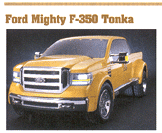
Ford Mighty F-350 Tonka
This one’s a tad bigger than the truck you may have had as a child. And it’s turbocharged with a 6.0-liter, V8 diesel engine that generates 350 horsepower and 600 ft.-lb. of torque when teamed with the PowerTorq automatic transmission. While that pick up may impress some, others may ask, “Will I get more than five miles to a gallon?” Probably. The vehicle features still-developing technology called Hydraulic Launch Assist that helps lower emissions and achieve better fuel economy. Other nifty features include an air suspension that allows the truck to “kneel” for easier boarding and a camera-operated lane-change system.
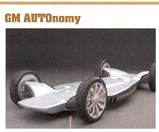
GM AUTOnomy
No, it’s not a giant skateboard. It’s the chassis of GM’s AUTOnomy concept car. The AUTOnomy contains fuel cells, hydrogen fuel tanks and the electronics for by-wire functions, and the design allows for a wide variety of vehicles to be built on a small number of platforms. That means customers could lease multiple body styles that are easy to switch, depending on their needs. New technology also eliminates foot pedals, the instrument panel and the steering column, allowing the driver to sit anywhere – and changing the meaning of backseat driver forever.
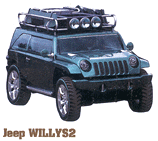
Jeep WILLYS2
While its battle-proven World War II ancestor, the Willys MB, was made of sheet metal, this concept was built in carbon fiber to simulate the weight savings that could be achieved with injection-molded plastics. It also screams “accessories” with a roof rack, an integrated luggage carrier, bindings for multiple kinds of outdoor gear, and three auxiliary search and rescue lamps. The Jeep Willys2 is powered by a 1.6-liter, in-line four-cylinder engine that’s been supercharged to deliver 160 hp and 155 lb.-ft. of torque. Its four-speed automatic transmission is coupled with a shift-on-the-fly transfer case with full-time four-wheel drive and low-range modes. Estimated performance figures include a sprint to 60 mph in about 10 seconds and a top speed of nearly 90 mph.
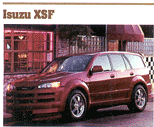
Isuzu XSF
Isuzu pegs its Axiom XSF as an “excessive” street performance vehicle – made possible by its 275-horsepower supercharged 3.5-liter engine, Elbach-tuned performance suspension and Brembo brakes. The performance angle is further enhanced with Recaro Sport seats and drilled aluminum pedals. It also includes a ground-effects body kit, a custom black-mesh grille and quad fog lights.

Toyota ccX
While not intended for production, the Concept Coupe Crossover from Toyota does “reflect a new approach to future small-car development.”
Aimed at younger consumers, the ccX features a roof that’s comprised of two large power sunroofs, each made up of four glass panels that, when tilted,
create openings over the entire passenger compartment and cargo area. The rear cargo area is equipped with six hidden tie-down hooks for hauling and,
perhaps most importantly to a young consumer, an electric-powered removable cooler that plugs into a 12-volt power source.
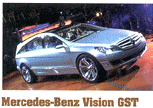
Mercedes-Benz Vision GST
The GST stands for “Grand Sports Tourer,” the new politically correct term for “four-door luxury wagon.” This all-wheel-drive wagon seats six; combines technology and performance with a 360-horsepower 5.5-liter, AMG-tuned V8 engine; and sports a glass roof so you can fully appreciate those sunny summer days. Kids driving you crazy, wanting to know if you’re there yet? Not in this wagon. Kids can occupy themselves by playing video games and DVDs.
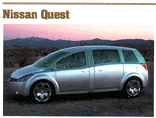
Nissan Quest
A parent’s dream, the Nissan Quest concept takes full advantage of the minivan’s greatest strengths – roominess and flexibility – and throws in some new gadgets as well. Interior highlights include a center-mounted table-top control console, angled inward to ease movement between the two front seats. The Quest also offers a camera for monitoring occupants of rear-facing child seats, and replaces side and rear-view mirrors with cameras that display images on a large screen in the center console. The full-length overhead console features dual entertainment system displays, along with audio climate control for rear passengers and additional personal lighting and storage.
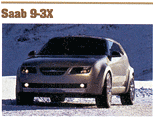
Saab 9-3X
For the first time in its history, Saab has combined elements of a pickup truck and an off-road vehicle with a sports coupe design that still seats four. The 9-3X features two power sliding-glass roof panels that can be detached and towed and, with the push of a button, its seats fold flat and its pickup-bed floor extends electronically. This all-wheel-drive vehicle is powered with a turbocharged, 3.0-liter V6 engine and could actually serve as your office: You can access your e-mail and the Internet from a centralized unit that also controls satellite navigation, radio, CD, TV and DVD system.
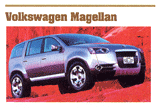
Volkswagen Magellan
The automotive buzzword of the day is “crossover,” and that’s exactly what this concept is: part SUV, part station wagon and part minivan. The 275-horsepower W8 engine is mated to a Tiptronic transmission, while the interior features an “infotainment module” located in a central instrument panel. And if you lack a sense of direction, the Magellan features the “GPS to Go” system, which can be removed for off-road guidance while hiking or biking. (Good news guys! You’ll never have to ask for directions again. Oops … I forgot. Men don’t ask for directions.)
Writer Debbie Briggs is managing editor of BodyShop Business.













